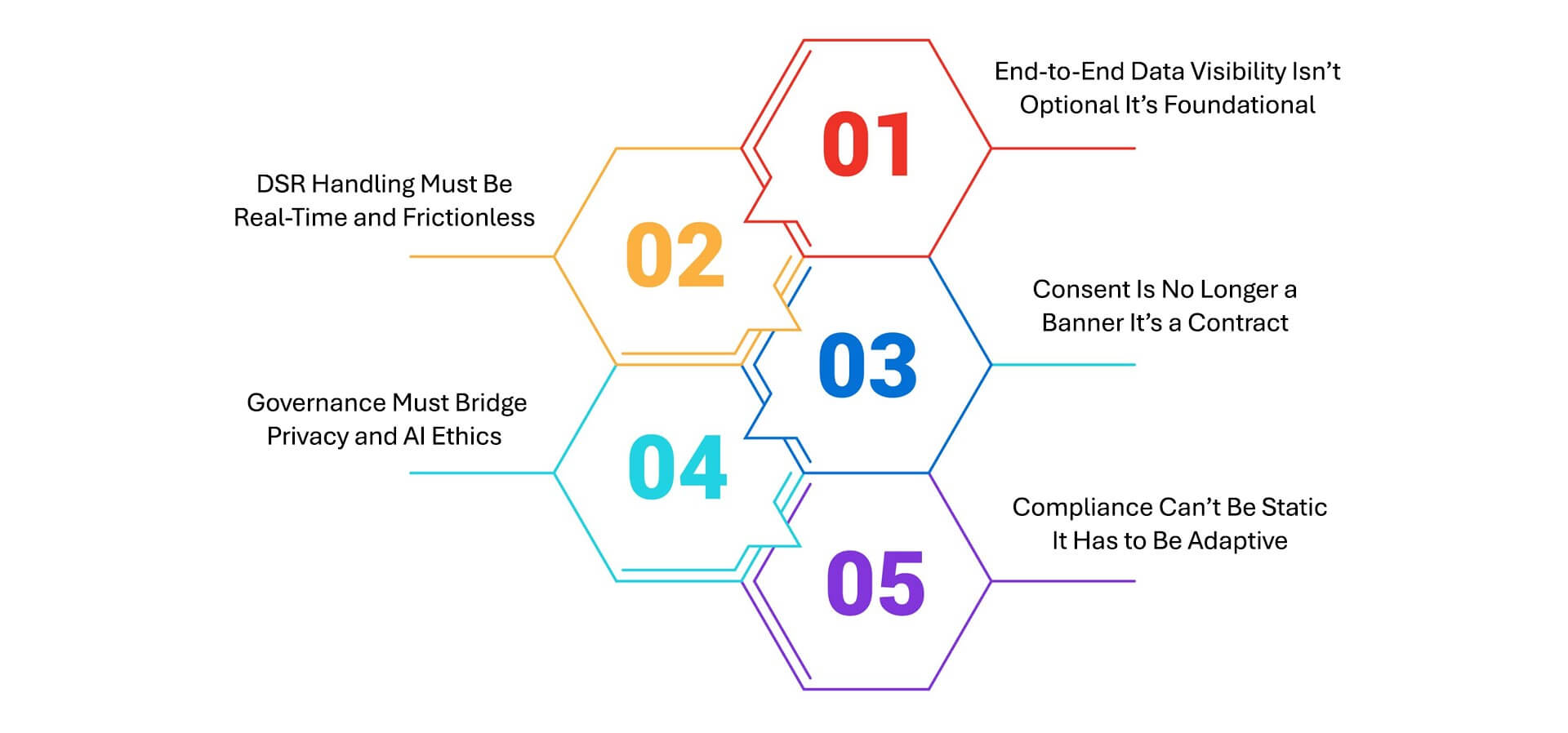What is the CCPA?
The California Consumer Privacy Act (CCPA) is a landmark data privacy law that went into effect on January 1, 2020, making California the first U.S. state to give consumers comprehensive rights over their data. It empowers California residents with visibility, access, and control over how businesses collect, use, and share their personal information.
CCPA applies to for-profit entities doing business in California that meet at least one of the following thresholds:
- Have annual gross revenues over $25 million;
- Buy, receive, or sell personal information of 100,000 or more California residents, households, or devices;
- Derive 50% or more of annual revenues from selling personal data.
With the passage of the California Privacy Rights Act (CPRA) in 2023, the CCPA was strengthened further, extending protections, creating new enforcement bodies, and aligning more closely with global frameworks like the GDPR.
Why the CCPA Matters
The CCPA marked a fundamental shift in how U.S. organizations think about consumer data—not as an internal asset, but as something consumers have the right to govern. It redefined digital interactions in the U.S. by prioritizing transparency, consent, and accountability, influencing other state laws like Virginia’s CDPA and Colorado’s CPA.
In today’s landscape of AI, hyper-personalization, and massive data collection, CCPA compliance is more than legal hygiene—it’s a public expectation and a brand trust imperative. Organizations that proactively embrace their principles position themselves as privacy-forward leaders in an increasingly regulated digital economy.
Core Rights Under the CCPA
- Right to Know: Consumers can request what personal information is collected, used, shared, or sold.
- Right to Delete: Consumers can request deletion of their personal information (with certain exceptions).
- Right to Opt-Out: Consumers can opt out of the sale of their personal data.
- Right to Correct: Consumers can request correction of inaccurate personal information.
- Right to Limit Use of Sensitive Data: Consumers can restrict how their sensitive data is used (e.g., precise geolocation, biometric data).
- Non-Discrimination: Businesses cannot penalize consumers for exercising their rights.
Navigating CCPA in 2025: What Enterprises Must Get Right

As privacy expectations evolve and enforcement intensifies, the CCPA has shifted from a reactive compliance task to a proactive business function. With the CPRA expansion in full effect and new U.S. state laws creating a patchwork of privacy requirements, 2025 is the year enterprises must operationalize privacy at scale, and the CCPA is the blueprint.
Here’s what forward-thinking organizations are prioritizing:
1. End-to-End Data Visibility Isn’t Optional—It’s Foundational
You can’t protect or manage what you can’t see. Enterprises must have real-time insight into where personal data lives, flows, and changes across hybrid cloud, SaaS platforms, internal apps, and unstructured files.
What to focus on: Unified data discovery and classification tools that surface personal, sensitive, and regulated data across ecosystems.
2. DSR Handling Must Be Real-Time and Frictionless
Manual responses to Data Subject Requests (DSRs) can’t keep up with regulatory timelines—or consumer expectations. Businesses are moving toward intelligent DSR automation, with secure portals and auto-generated, redacted reports.
What to focus on: Scalable SAR and DSR orchestration, backed by audit logs and automated verification workflows.
3. Consent Is No Longer a Banner—It’s a Contract
CCPA compliance around opt-outs and the “Do Not Sell” mandate demands more than website footers. It requires traceable consent logging, preference enforcement across platforms, and real-time syncing with marketing tools.
What to focus on: Centralized consent management integrated into customer-facing channels and backend data systems.
4. Governance Must Bridge Privacy and AI Ethics
AI models increasingly rely on personal data—behavioral, demographic, and sensitive attributes. Under CCPA and CPRA, businesses must prove the responsible use of this data, with clear lineage and justification for processing.
What to focus on: Linking privacy governance with AI/ML pipelines for data traceability, purpose limitation, and explainability.
5. Compliance Can’t Be Static—It Has to Be Adaptive
CCPA is no longer isolated. With new state-level laws emerging (like the Colorado Privacy Act and Virginia’s CDPA), enterprises must take a harmonized approach to privacy compliance.
What to focus on: Policy-driven platforms that adapt enforcement based on region, data type, and legal requirements, reducing duplication and audit fatigue.
Bottom line? In 2025, privacy isn’t just a legal issue—it’s a product requirement, a data architecture principle, and a pillar of customer trust. Enterprises that treat CCPA as a strategic enabler—not a regulatory burden—will build the resilience, agility, and credibility to lead in the privacy-first era.
CCPA and the AI-Driven Future: Redefining Privacy as a Design Standard
As AI becomes embedded in every layer of business, powering decisions, predictions, and personalization, data privacy is no longer a constraint. It’s a strategic litmus test for responsible innovation. The CCPA, especially in its post-CPRA form, isn’t just a checklist for compliance—it’s the ethical scaffolding on which AI credibility is built.
The lines between data utility and data exploitation are getting thinner. With AI systems ingesting behavioral, contextual, and biometric signals at scale, organizations must answer hard questions:
Who owns this data? What rights does the individual retain? Can you explain your algorithm’s decision to a regulator or a consumer?
This is where CCPA evolves from legal text to enterprise posture. Article-based protections—like the right to access, delete, or opt out—are morphing into functional AI governance requirements. Every training dataset, every inferred attribute, every recommendation made must now pass the test of accountability, explainability, and intent.
More importantly, CCPA is no longer a California conversation. Its core principles—purpose limitation, transparency, and user control—are now embedded in global privacy movements and shaping draft U.S. federal legislation. In that sense, CCPA is acting as both a regional guardrail and a global prototype for data ethics in the algorithmic era.
Enterprises that recognize this shift are treating privacy not as a risk to be managed but as a foundation of trust. They’re embedding privacy by design into their data pipelines, AI workflows, and digital experiences—not because the law demands it, but because the market rewards it.
The CCPA ushered in a new era of privacy in the United States—placing power back into the hands of the consumer and forcing organizations to treat data stewardship as a core responsibility. For enterprises, it offers both a challenge and an opportunity: to modernize data operations, align with global norms, and lead with transparency.
Because in today’s trust economy, how you collect, manage, and protect personal data defines your license to operate.
Getting Started with Data Dynamics:
- Learn about Unstructured Data Management
- Schedule a demo with our team
- Read the latest blog: How Data Sovereignty Is Challenging Data Governance — And What the Future Demands






